What's the best solar panel for a campervan?
If you’re new to campervan electrics, searching for the right solar panel might feel like an endless maze of questions and unknowns. What brand should I go for? How many watts do I need? What does ‘monocrystalline’ even mean?!
Luckily, choosing a campervan solar panel isn’t as difficult as it might seem. You just need to be clued up on all the facts before making a decision. Here’s a rundown of everything you need to know to choose the best solar panel for your campervan.
How does a solar panel work?
Solar panels are a really popular, sustainable method of charging campervan leisure batteries. With the right electrical system and some good sunshine, solar panels can take your campervan completely off-grid, letting you chill out in your favourite camping spot, explore your home country, or even travel the world without needing to worry about plugging into electric hook up.
The solar panels used for off-grid electrical systems are photovoltaic (or PV) which means they convert sunlight into electricity. A solar panel contains a group of photovoltaic cells connected together, made from a semi-conductor such as silicon. When light particles (photons) reach the solar panel, they knock the electrons within the silicon free which generates electricity. The greater the intensity of the light, the greater the flow of electricity.
Because the voltage and current from a solar panel is variable, you always need a charge controller to filter the power before connecting it to your battery. A charge controller will regulate the voltage from the panel and draw the ideal current to charge a leisure battery efficiently.
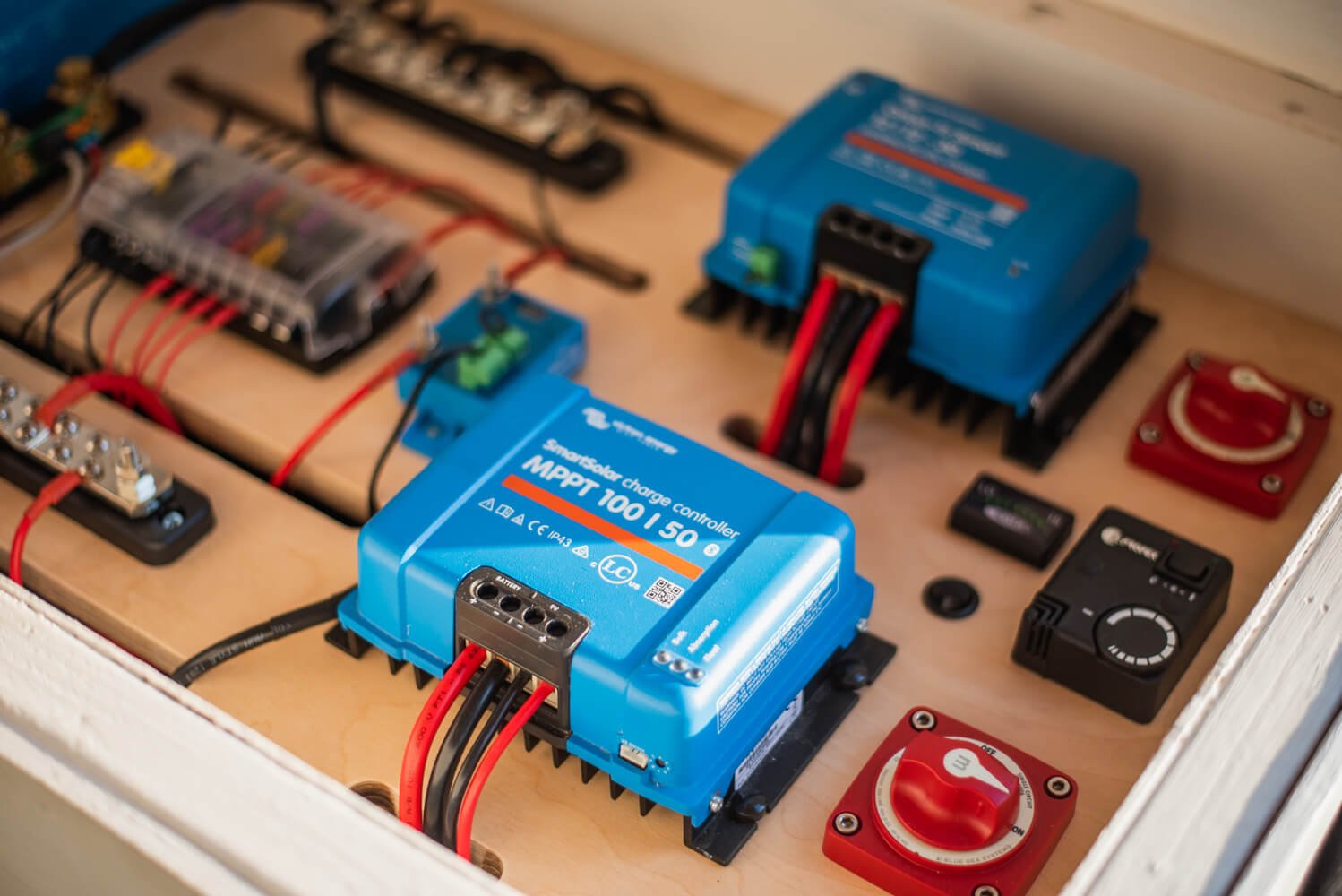
An MPPT campervan charge controller
Different types of solar panel
Before working out what size you need, there are a few different types of solar panel you’ll need to be aware of:
- Monocrystalline or polycrystalline
- Rigid or flexible
- Portable or fixed
Monocrystalline vs polycrystalline solar panels
It’s easy to get caught up in the technical difference between these two panel types, but it basically comes down to this: monocrystalline solar panels are slightly more expensive, but also more efficient.
The cells of monocrystalline panels are composed of a single piece of silicon, whereas the cells of polycrystalline panels contain multiple pieces of silicon which are blended together. As a result, mono panels are slightly more efficient, but more expensive to produce.

From our shared experiences living off-grid, we’ve found that trying to harvest enough power from solar panels can sometimes be a bit of a battle, especially in poorer weather conditions (especially important if you live somewhere like the U.K.!). We would always recommend monocrystalline panels as they will perform better when the conditions are less ideal.
Rigid vs flexible solar panels
Rigid solar panels are the obvious choice for most campervans, but it’s worth discussing a couple of special cases which will benefit from the advantages of flexible panels.
Flexible solar panels are lightweight, thin and bendable, making them ideal for two different use cases: if you have an unusual, curved roof which wouldn’t easily mount a rigid panel (such as an old motorhome), or if stealth camping is a top priority (as they can be mounted flat to your van’s roof, keeping them really low profile).
Since flexible panels can be mounted flat to the van’s roof, they can be really low profile and can’t be seen from ground level. However, solar panels become significantly less efficient if they get too hot, so we always recommend ensuring there is sufficient airflow below your solar panels to keep them cool. Mounting flexible panels directly onto a metal van roof could reduce their power output and shorten their lifespan.
If you’re planning to use solar as your primary source of power, we recommend using rigid solar panels. They are more efficient and also more durable; their aluminium frame and glass top make them much more resistant to damage from scraping branches, heavy snow or hard frost.
Ready-to-go solar kits Designed by experts 🔧
Our kits are designed by engineers to be safe and robust. Plus – when you purchase, we’ll send you a free wiring diagram and installation guide.
Shop nowPortable solar panels
If your campervan roof is choc-a-blok with skylights, bouldering mats, an awning and a wooden deck for watching the sunset, you might suddenly realise you don’t have any room for a solar panel up there! Never fear – there is a solution.
Portable solar panels can be transported in your van, then brought out and plugged in when you’re parked up and the sun’s out. You can either connect them up to charge your in-house leisure battery via a charge controller, or you can combine them with a portable powerbank which acts as a battery, charge-controller and inverter all rolled into one. If you’re considering purchasing a portable power station, have a read of our article: Which is the right portable power station for me?
Portable power stations are a great option for someone converting a smaller campervan who still wants access to 12V and 230V power with zero installation!
Nevertheless, if you want to rely on solar as your main source of power, setting up and plugging in a portable panel every time you stop would become pretty tedious. If you’re worried about installation, we have plenty of advice to give in our book, The Van Conversion Bible, and through our free electrical system design service.


What size solar panel do I need?
Now that you know which type of solar panel you need, it’s time to decide what size to go for, or more precisely, what power rating. The power rating, or wattage (W), of a solar panel gives an indication of how much power it will provide to charge your battery bank. Choosing how much power you need from your solar panels will depend on the size of your battery bank and how long you want to last off-grid. But it may also be limited by your budget and how much space you have on your roof.
To estimate how much charging power you will need to fully recharge your batteries, you need to know the total ‘usable capacity‘ of your battery bank in watt hours. Usable capacity refers to the amount of your battery bank you’re able to access. For example, it’s recommended that you don’t regularly discharge AGM batteries more than 80%. So the usable capacity of a 100Ah AGM battery would be:
100Ah x 80% = 80A
Next, you can convert the amp hours (Ah) to watt hours (Wh) by multiplying by the voltage of the battery:
Power (Wh) = current (A) x voltage (V)
80Ah x 12V = 960Wh
The solar panels you choose to install will directly affect how quickly your batteries are charged. There are a number of factors you need to consider when calculating how quickly your battery bank will recharge:
- Size of battery bank in watt hours
- Size of solar panel in watts
- Battery recharging efficiency (AGM = 85%, lithium = 95%)
- Angle of the sun in the sky
As solar panels on a campervan will be mounted flat to the roof of the van, it’s important to consider the angle of the sun. In summer this will only decrease efficiency by a small amount. However, in winter, this will have a much bigger impact.
For example, in London, a solar panel in summer will be 92% effective due to the angle of the sun. In comparison, in winter, the solar panel would only be 24% effective. This is a pretty massive difference and worth factoring in if you will use your van in the winter!

Example
For a 200Ah AGM 12V battery bank:
200Ah x 12V = 2400Wh
(2400Wh x 80% usable capacity) ÷ 85% recharge efficiency = 2259Wh to recharge to full
A 200W solar panel would fully charge the battery bank from 20% to 100% in:
200W x 92% effectiveness in summer = 184W
2259Wh ÷ 184W = 12.3 hours to fully recharge in summer
If we repeat the calculation for winter:
200W x 24% effectiveness in winter = 48W
2259Wh ÷ 48W = 47 hours to fully recharge in winter
As you can see, especially if you live in Northern Europe, recharging in winter is much slower than recharge in summer. This means that if you will use your van in winter, it’s a good idea to have a larger solar array. On the flipside, if you will only use your van in summer, you can opt for a smaller solar array.

These calculations give you a rough idea of how much solar power you need to charge your battery bank, but the decision will also be affected by how much you want to rely on solar as your main source of power.
If you tend to get itchy feet and never spend more than a few days in one place, you can also rely on a VSR or battery to battery charger to charge your leisure batteries from the power of your engine. Alternatively, if you plan on spending a lot of time on campsites, connected to shore power, you won’t be as reliant on your solar panels and won’t need such a high power rating.
How many solar panels should I install?
Now that you’ve estimated how many watts of solar power you need, there may be more than one way to achieve that wattage. For example, if you need 200W, you could either buy one 200W panel or you could connect two 100W panels together. This may seem like you’re achieving the same thing, but the resultant electrical output may be very different. You need to dig a little deeper into the solar panel’s specifications to make sure it will provide a high enough voltage to charge your batteries, even in sub-par conditions.
Open circuit voltage
Open circuit voltage (Voc) is the maximum voltage the panel can produce when there is no load on it (i.e. when measured with a multimeter). If you apply a load across the panel, such as a charge controller, the voltage will decrease. This graph marks the Voc at the point of zero current and shows how the voltage reduces as the current increases.
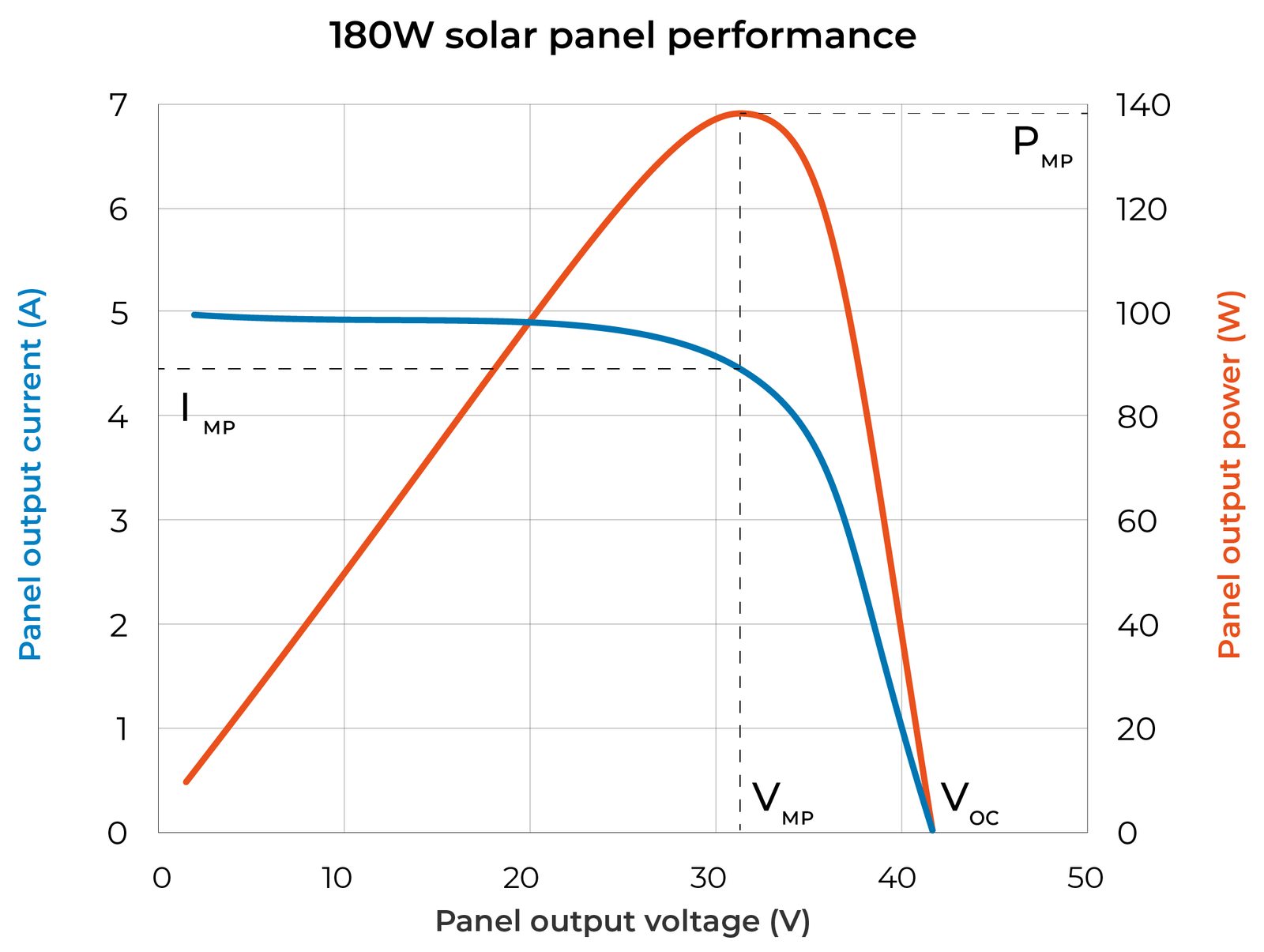
Since power is a product of voltage and current (P=IV), we can track how much power is produced as more current is drawn. There is a point at which the power reaches a peak before it decreases. This is called the maximum power point and is the same value which is used to describe the wattage of the panel.
In other words, there is an ideal current at which the power drawn from the panel will be at a maximum. The current and voltage at this point are called Imp and Vmp respectively. MPPT charge controllers make use of this point by drawing the ideal current to maximise the power output.
The open circuit voltage is a useful parameter when choosing your solar panels because it indicates whether or not the solar panel’s voltage will be high enough for your leisure batteries to begin to charge.
Leisure batteries have a minimum voltage required to fully charge; for 12V lithium and AGM leisure batteries, the threshold voltage is usually around 14V. This means that your solar panels need to be generating a voltage of at least 14V in order to charge your batteries.
So if the Voc of your solar panel is greater than 14V, then we’re all good! Right?
The problem is, these specifications are all measured at ‘standard test conditions’ which is at an irradiance of 1000W/m2 and a temperature of 25oC. This is equivalent to the radiation a panel would receive in ideal conditions, when the sun is directly above it, i.e. at midday in the summer, with a cloudless sky and a light breeze to keep the panel cool.
Whenever a solar panel is receiving less than 1000W/m2 of light, the maximum power and open circuit voltage will actually be much less.
On a hazy day where a thin film of cloud covers the sun, the input energy will decrease by around 50%, and on a day with heavy cloud and rain, your panels might not be able to produce any power at all.
The solar panel will be most efficient when light hits it square on, not from an angle. In the morning and afternoon, or in winter, when the sun stays low in the sky throughout the day, the solar panel’s output will be much lower. As we mentioned previously, your solar panels will only be 24% effective in London in the winter!
Example
The Victron 175W rigid solar panel has a Voc of 23.7V.
On a hazy day with 50% effectiveness:
23.7V x 50% = 11.85V
As this voltage is below the 14V required to charge, the solar panel will not charge the leisure batteries.
In comparison, the Victron 90W solar panels have a Voc of 24.06V. Two 90W panels wired in series would create a 180W solar array with a Voc of 48.12V.
On a hazy day with 50% effectiveness:
48.12V x 50% = 24.06V
As this voltage is above the 14V required to charge, the solar panels will charge the leisure batteries.

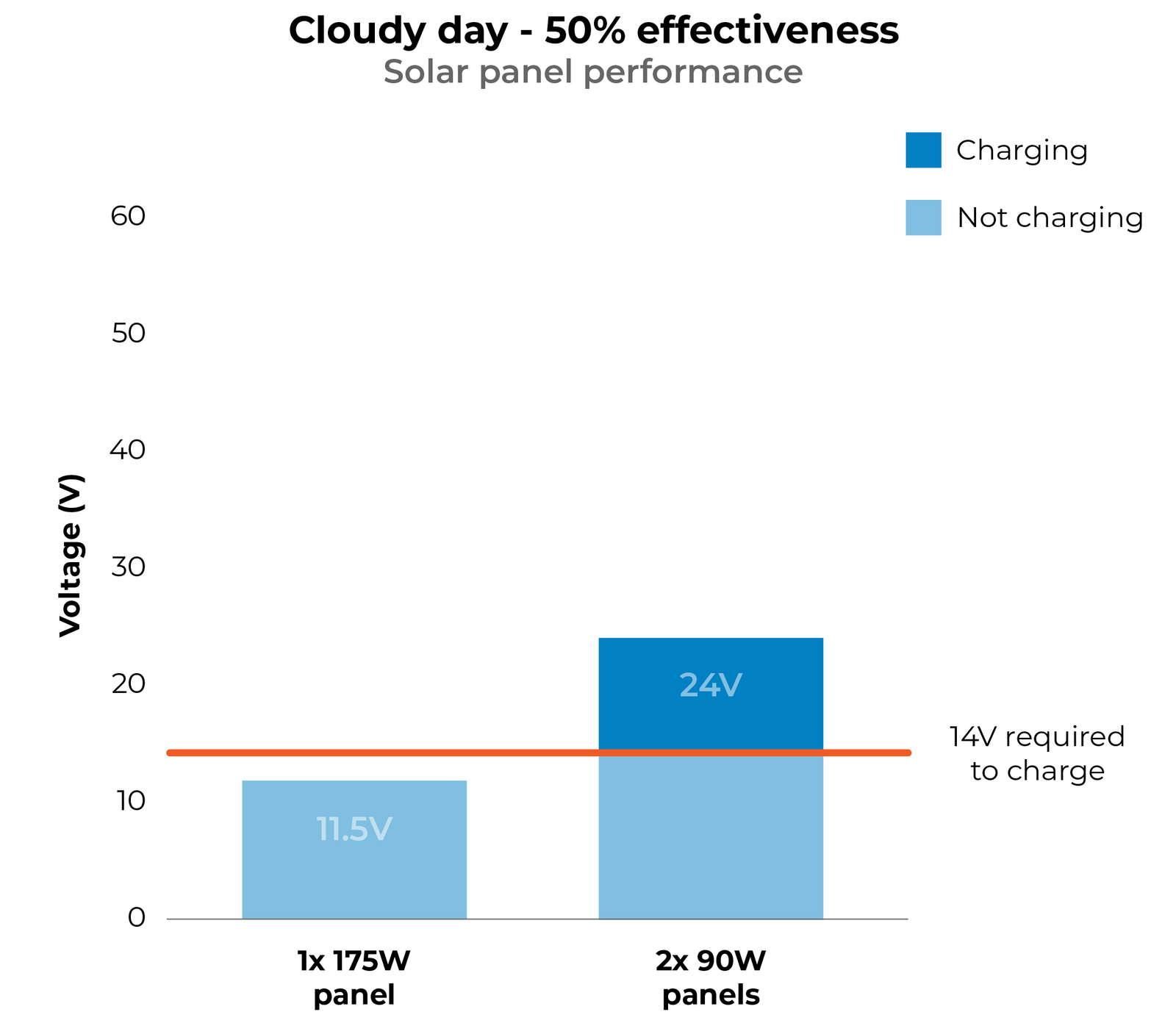
Ease of installation
The other consideration when deciding how many solar panels to install is the ease of installation. The more solar panels you install, the more holes you will have to drill in your roof (if you’re opting for rigid panels with Z brackets)! We’d recommend installing as few solar panels as possible whilst still achieving a high open circuit voltage.
Campervan solar panel brands
Victron vs Renogy solar panels
There are a few different brands that produce good quality solar panels designed for small off-grid systems, but Victron Energy are market leaders in high quality electrical system components.
Often when comparing Victron vs Renogy solar panels, although the wattage is very similar, the open circuit voltage of the Victron solar panel will be much higher.
For example, the 200W Renogy panel has an open circuit voltage of 27V, but the 215W Victron panel has an open circuit voltage of 45.8V. As we’ve already seen, this higher Voc can be really advantageous if you’ll be using your camper in a country with more cloud cover.
Since the price of the panels is very similar, we would always recommend choosing the Victron solar panels over Renogy where possible.
Additionally, we have had a lot of reliability and quality issues with Renogy over the past few months. Therefore, we would recommend not installing Renogy solar panels, or any other Renogy components for that matter.
Unbranded solar panels
We now have a range of unbranded solar panels available on our webshop. These come with a 1 year warranty, and are available in a range of sizes. It’s worth browsing the unbranded panels as some have high open circuit voltages, and are quite affordable options.
For example, the 200W monocrystalline solar panel has an open circuit voltage of 45V, comparable to the 215W Victron solar panel.


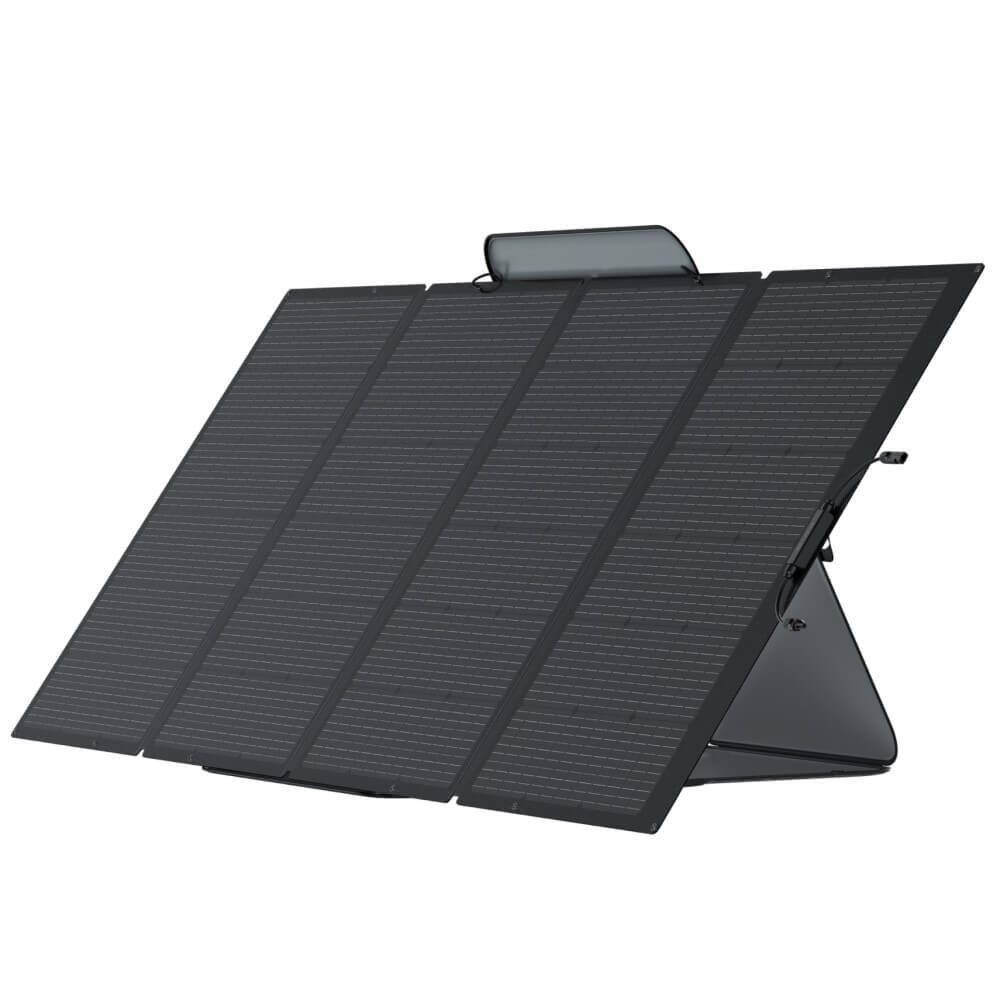

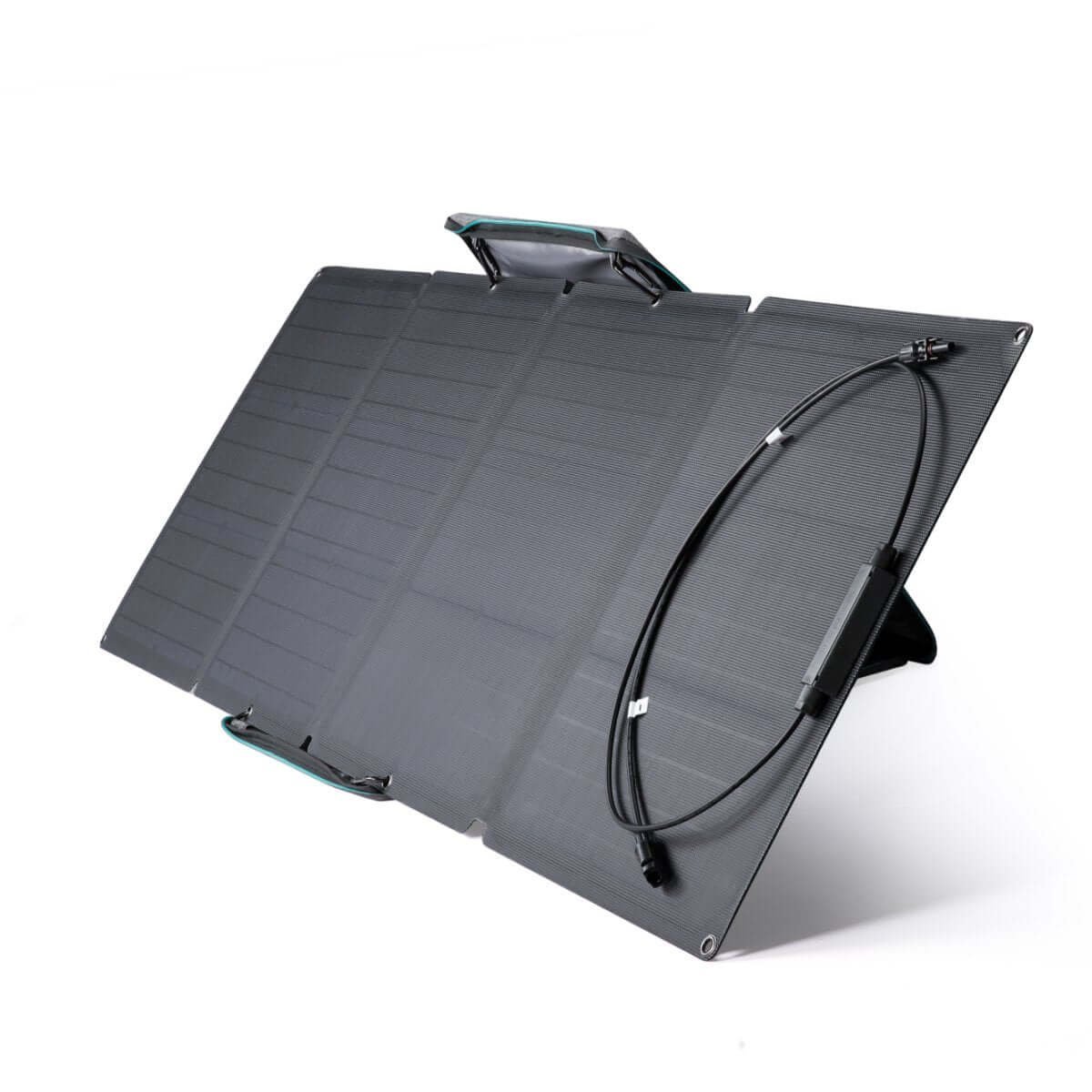

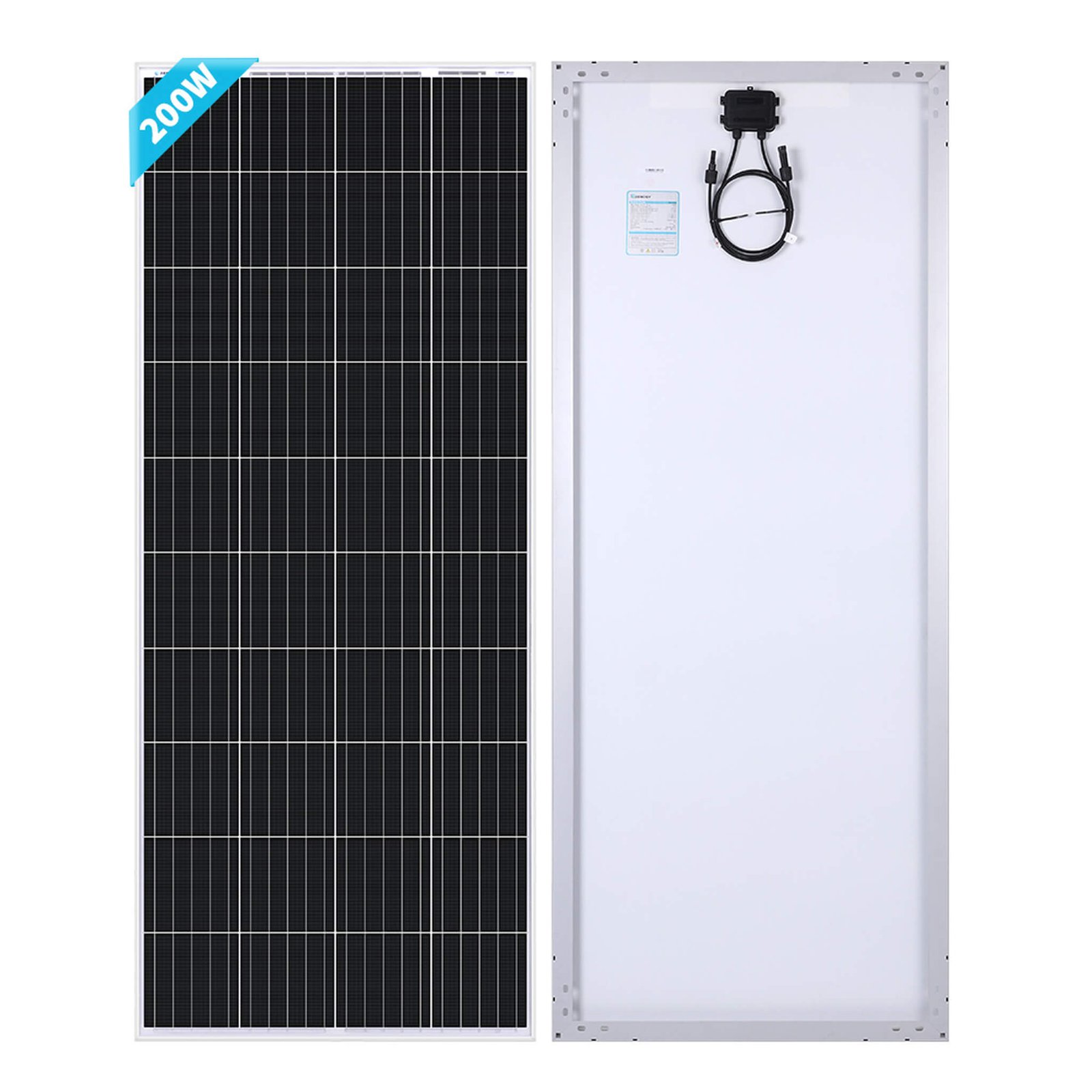
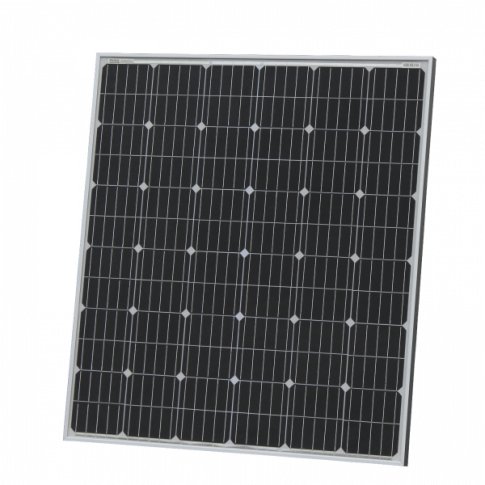

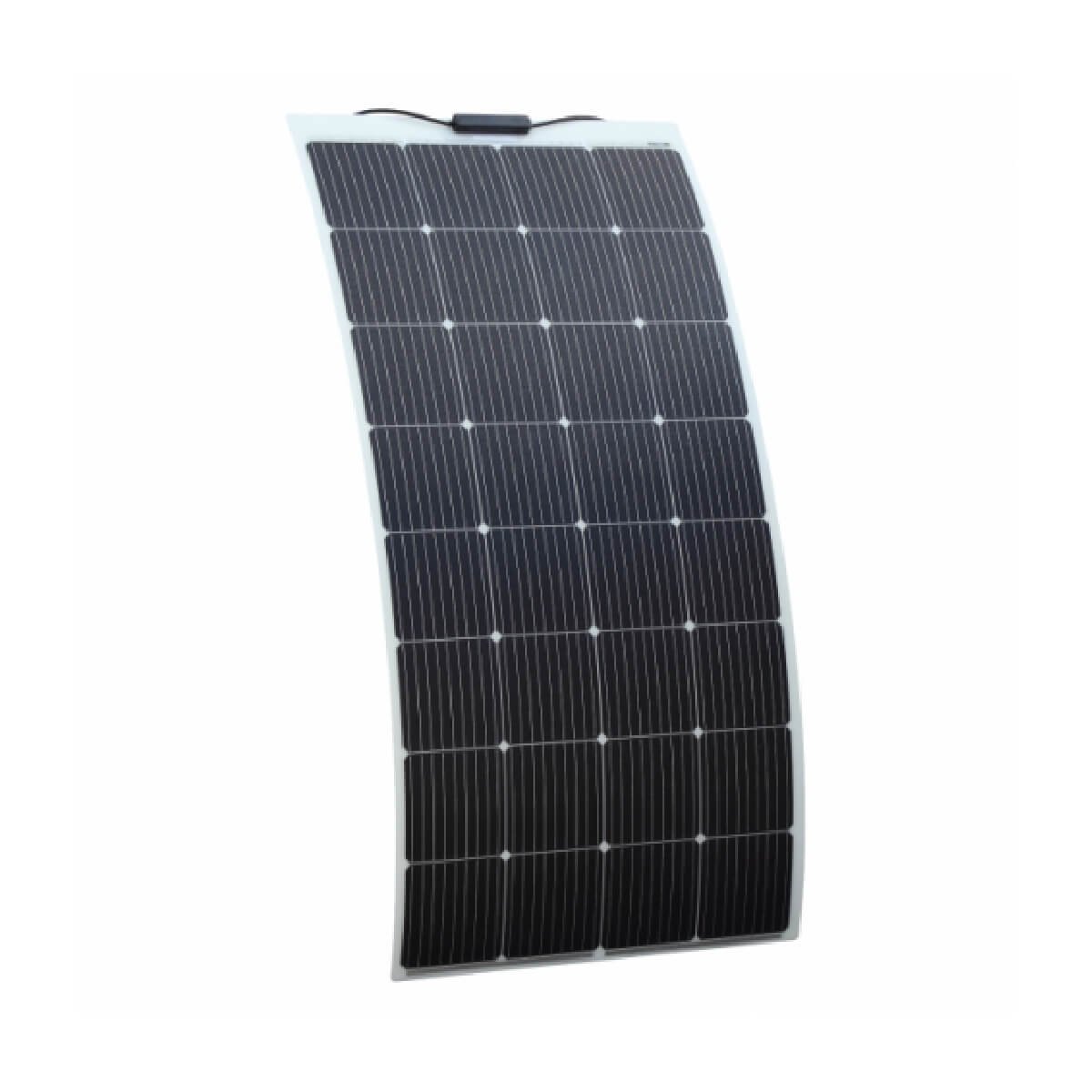
Hello,
Nice article/website.
I have a question regarding the drop in Voc with falling W/m2 .
From this Victron site this article:
https://www.victronenergy.com/blog/2020/02/20/pv-panel-output-voltage-shadow-effect/
Indicates that there is a small drop in Voc with decreasing W/m2 however it is unclear what the threshold is before it drops below the min battery voltage.
I do not have much space on the roof and am just wondering if it is worth getting two small rather than one large in order to avoid no charge during overcast skies.
Thanks
Hi Alistair,
Thank you!
Whether one or two panels is best depends on the specific panels in question. However, light intensity tends to impact current more than voltage. So, for a lot of setups, panels have to be significantly shaded for a large voltage reduction. For a 12V system, any solar panel with an open circuit voltage (Voc) of around 20V will be fine and one panel would do the trick.
We hope this helps!
Hi,
Thanks for all the info and advice.
A quick question about efficiencies:
My 275W panel is rated as 16% efficient (for reference the newest one I could find had 25% efficiency)
Your calculations don’t seem to take this efficiency into account. How would you factor this into the equations?
Or would you not need to? Does it work that a 275W panel will output 275W in ideal 1000w/m2 conditions REGARDLESS of its stated efficiency? If so, the then the sun angles in summer/winter (92&24%) as stated are the only factors you need to consider?
The chart of KWh daily yield by country is most useful, but what kind of efficiency system is this based on?
Yes you are right – the 275W rating has already taken the % efficiency into account. The efficiency figure can be important if you have limited space. The KWh daily yield is an absolute value, the efficiency of the panel has already been factored in.